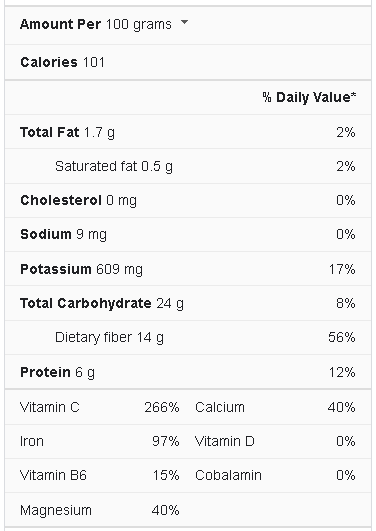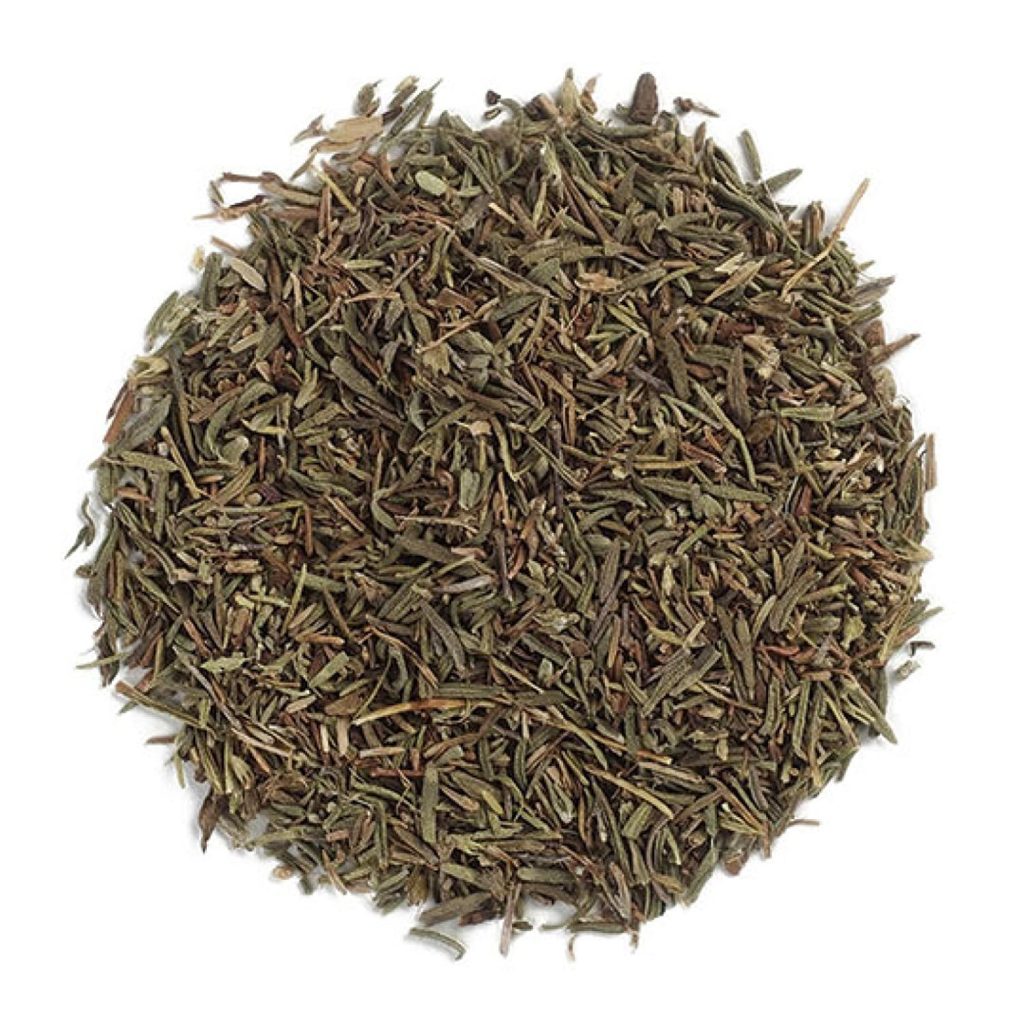Thyme has a pleasant aroma and is high in vitamin C, vitamin A, and B. The vitamin C content of a 100-gram serving of fresh thyme leaves is 266%, and 1.28 milligrams of vitamin C are found in a 1-teaspoon serving. Fresh or dried thyme can be used to make thyme tea, and the nutrients per serving will vary slightly depending on the recipe.
Thyme Nutrition Facts
What Is Thyme?
While thyme is widely used to flavor food, it has been used for many health and therapeutic purposes and preservatives since ancient times. It’s now found in many goods, including mouthwashes, teas, and even nasal sprays. Thyme is a mint family plant with small, sage-green leaves and thin stalks. Fresh, dried, or converted as an essential oil can be used. While many health claims have been made regarding thyme, most have yet to be proven by scientific research.
However, the chemical Thymol found in thyme can help reduce or neutralize bacterial, parasitic, fungal, or viral infections. According to research, it may also contain analgesic, antibacterial, antiviral, and anti-inflammatory qualities, which could assist with skin disorders, bug bite pain, rheumatoid arthritis, and more.
Health Benefits Of Thyme
Here are some health benefits of thyme:
- Thyme has a high thymol content in its essential oil. Thymol is a natural expectorant, which means it can help you stop coughing, relieve chest congestion, and avoid colds.
- Apart from expectorant qualities, the essential oil thymol has bronchial antispasmodic effects, making thyme an effective treatment for acute and chronic bronchitis, sore throats, whooping cough, asthma, laryngitis, and upper respiratory tract irritation.
- The antiseptic, antibacterial, and antioxidant properties of thymol oil are well-known, and it’s a common ingredient in mouthwashes for treating mouth and throat infections.
- Thyme’s antibacterial properties make it an excellent treatment for yeast, fungal, and bacterial infections. Externally, thymol-containing ointments treat bug bites and other skin lesions.
- This wonder herb is recognized for relaxing stomach muscles, which helps with stomach upsets, chronic gastritis, lack of appetite, indigestion, stomach cramps, irritable bowel syndrome, and colic, among other gastrointestinal issues. It also aids in the dissolution and removal of mucus from the intestinal tract.
- Thyme’s antispasmodic properties are beneficial in the treatment of heart problems. Thyme oil, in particular, is excellent for relaxing strained arteries and veins, lowering blood pressure, and supporting heart health.
- Thyme contains the primary terpenoids, rosmarinic, and ursolic acids, both of which have been linked to cancer prevention. The amount of DHA (docosahexaenoic acid, an omega-3 fatty acid) in the brain, kidney, and heart cell membranes increases with regular thyme consumption.
- Thyme helps with other diseases, including minor sore throats, postnasal drip, sciatica, gout, headaches, rheumatic aches, nerve stimulation, Alzheimer’s disease, macular degeneration, menstrual cramps, diarrhea, premenstrual syndrome, menopausal symptoms, epilepsy, and convulsions.
- When it comes to maintaining and improving skin health, traditional herbal remedies are popular. In Ethiopia, a study found that combining a 3 percent thyme essential oil antifungal cream with a 10% chamomile extract cream helped treat eczema-like lesions on the skin. Additional scientific investigation is, however, required.
- Thyme’s usage as a respiratory agent is one of the most well-known and long-standing uses in traditional medicine. Thyme is an expectorant and anti-inflammatory that can help with bronchitis, persistent asthma, congestion, colds, flu, blocked sinuses, and seasonal allergies. It clears phlegm and mucus from the respiratory tracts, reduces inflammation to make breathing more manageable, and prevents the growth of bacteria that might cause serious respiratory infections. That’s why steeping thyme in a strong tea is one of the most effective ways to relieve respiratory problems.
How To Prepare Thyme?
Thyme can be grown or bought fresh or dried at most grocery stores. Fresh thyme should be refrigerated or frozen, and dried thyme can be stored at room temperature. If you’re buying thyme as an essential oil, keep it in the refrigerator or a cold, dry place away from direct sunlight.
Thyme is a herb commonly used to flavor meats, seafood, stews, and soups. Here are a few ways to include thyme into your cooking:
- Add fresh or dried thyme to vegetable, beef, or chicken stock
- Use it in stews or soups for added flavor
- Replace or cut back on salt in recipes by adding thyme
- Infuse your favorite tea with thyme
- Add thyme to your favorite chicken or pork recipes
- Add fresh thyme as a topping to baked potatoes
Uses for Different Types of Thyme
All species of thyme are attractive to bees, with tiny leaves and tubular-shaped flowers forming dense groups, and the honey produced by bees feeding on thyme blooms rivals that of the most OK lavender honey. Of course, thyme variations are sought for cooking, and “bouquet garni” in stews, soups, meat, fish, compound butter, eggs, dressings, and vegetable dishes are all traditional uses. Thyme goes well with lemon, garlic, and basil and can be used fresh or dried in any of the recipes above, or sprigs can be infused in oil or vinegar. Many types of thyme plants produce essential oils used in colognes, soaps, lotions, and even candles. In sachets, dried thyme is beautiful. Thyme leaves can be gathered before or after blooming, and it’s one of the few herbs where whether you use dried or fresh leaves don’t seem to make a difference in the flavor of your cuisine. However, because it takes a long time to release its oils, it should be used earlier in the cooking process.
Frontier Co-op Thyme Leaf
Features:
Types Of Thyme
Thyme comes in a variety of varieties. Because of its little prostrate form, typical time is the most extensively used. However, it is critical to understand which type is appropriate for cooking. If you’re unsure about the type to utilize, Here are some types:
Culinary Thyme Varieties
These thyme cultivars are planted primarily for culinary purposes, while several are also grown as ornamentals due to their vast clusters of white, pink, or purple flowers. Culinary thyme is a great way to attract pollinators to your vegetable garden, and the numerous blossoms attract both bees and butterflies.
Common Thyme
As you might expect, common thyme is the most extensively used culinary thyme. Common thyme thrives in a wide range of climates, from zones 3 to 8, and it overwinters consistently in zone 4/5 and spreads quickly. When cultivated at the warmer end of its range, the leaves will have a more robust flavor and a paler, narrower appearance.
Caraway Thyme
Caraway thyme is low-growing with narrow green leaves and light pink blossoms that are about 6 inches tall. Barons of beef, a large top round roast, were historically flavored with this kind of thyme. Caraway thyme may be grown in zones 4 through 8.
French Thyme/Summer Thyme
French thyme is similar to ordinary thyme. However, it is less hardy and should be grown as an annual north of zone 6. Its flavor is also said to be gentler and sweeter. Chefs prefer it because it grows up to twelve inches tall and has a more compact growth pattern than regular thyme.
Lemon Thyme
Lemon thyme has a lemony, citrus smell and is particularly well-suited to seafood, poultry, creamy sauces, and desserts. Lemon thyme thrives in a wide range of climates, and it has pink flowers and reaches a height of 6 to 12 inches.
Orange Balsam Thyme
Orange thyme contains orange-scented leaves, as you might expect. It has tiny gray-green leaves and delicate pink flowers and grows between 4 and 12 inches tall. According to the Missouri Botanical Garden, the flavor is considerably better fresh than dry, and it thrives in zones 5-8.
Orangelo Thyme
This is a newer orange-flavored cultivar that can reach a height of 2 feet. Burpee Seeds recommends using it fresh or dried in cooking.
Silver Queen Thyme
Another lemon thyme is Silver Queen, which is fantastic in tea and cooking. It features silver-edged leaves, as you might expect. Silver Queen thyme grows to be 3-12 inches tall, and it has pale lilac flowers and thrives in zones 5-8.
Summer Thyme
French thyme is another name for summer thyme. It has a narrower leaf than the English variety and is less hardy, growing annually in colder climes.
Ornamental Varieties of Thyme
These thymes are usually grown as ornamentals or ground covers:
Creeping Thyme
Creeping Thyme is a flat, ground-hugging plant that rarely grows higher than 3 inches. It has bluish-green leaves that are hairy and rich pink blooms. It’s commonly used in walkways and lawns since it can withstand many foot traffic. It thrives from zone 8 in the south to zone 4 or 5 in the north.
Minus
Minus is small thyme that only grows to be 6 inches tall. Butterflies are attracted to its stunning light-pink blossoms. Minus thrives in zones 4–8.
Mother Of Thyme
One of the frequent names for creeping or wild thyme is the mother of thyme. It’s a low-growing plant commonly seen in rock gardens and along sidewalks.
Wooly Thyme
Wooly thyme bears delicate pink blooms and tiny greyish leaves. The leaves and stems are woolly, as the name implies. It’s a flat creeping cultivar that rarely grows taller than 3 inches.
What Are The Side Effects Of Thyme?
When used in minor amounts in meals, thyme is considered safe. When consumed in more considerable amounts for therapeutic purposes, it may be safe for short periods; however, it may induce stomach difficulties when taken in huge numbers. It’s preferable to ingest this plant in normal meal levels rather than therapeutic amounts if you’re pregnant or nursing. If you’re allergic to oregano or other Lamiaceae species, you can be allergic to thyme as well. It may mimic estrogen in the body in women with hormone-sensitive illnesses such as breast cancer, ovarian cancer, uterine cancer, uterine fibroids, or endometriosis. If you have a condition that estrogen could worsen, stay away from it. This spice has the potential to impede blood clotting when consumed in high doses, so exercise caution if you have any clotting issues or are currently on blood thinners. It’s also advisable not to take it two weeks before surgery for the same reason.
Conclusion
The best thyme variety for cooking is the common thyme, and it is also the cheapest and most commonly used type. It has a high thymol content, the active ingredient in thyme essential oil. The French time is considered the best option for cooking, but it can be used in many other ways. If you’re looking for something more exotic and exciting, look for a scented variety. This herb’s high vitamin C content makes it a natural immune system booster. Vitamin C increases the creation of white blood cells, which are the body’s first line of defense against infection. Thymol is a critical component of thyme essential oil that is regarded as an immunomodulator, according to a 2018 article published in Phytotherapy Research.




